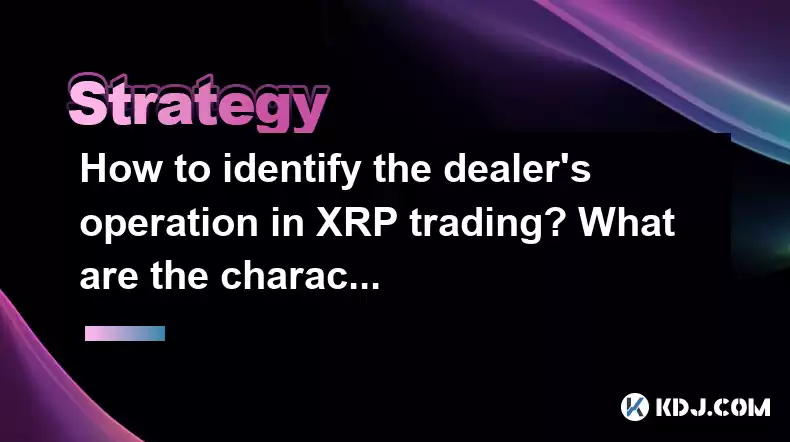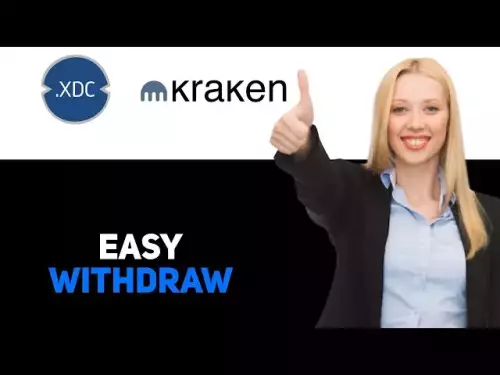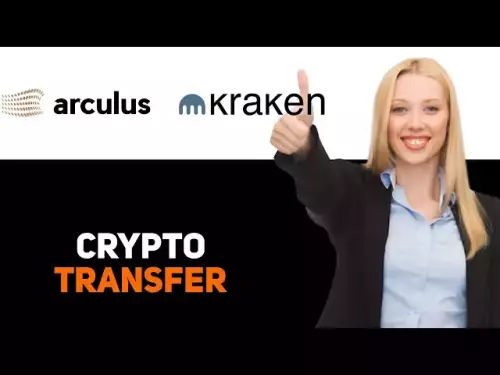-
 bitcoin
bitcoin $114684.631706 USD
-0.87% -
 ethereum
ethereum $4228.677447 USD
1.58% -
 bnb
bnb $1294.880693 USD
-1.16% -
 tether
tether $1.000819 USD
-0.02% -
 xrp
xrp $2.605138 USD
2.79% -
 solana
solana $209.908690 USD
5.89% -
 usd-coin
usd-coin $0.999903 USD
-0.03% -
 dogecoin
dogecoin $0.213423 USD
2.93% -
 tron
tron $0.322721 USD
-0.10% -
 cardano
cardano $0.727247 USD
3.66% -
 hyperliquid
hyperliquid $42.339456 USD
6.05% -
 chainlink
chainlink $19.910811 USD
5.16% -
 ethena-usde
ethena-usde $1.000557 USD
0.00% -
 stellar
stellar $0.349734 USD
2.69% -
 bitcoin-cash
bitcoin-cash $543.848687 USD
-0.21%
How to identify the dealer's operation in XRP trading? What are the characteristics of common scams
To protect XRP investments, watch for dealer operations via volume spikes and order book manipulation, and beware of scams like pump and dump and phishing.
May 01, 2025 at 02:22 pm

In the world of cryptocurrency trading, particularly with XRP, understanding the dealer's operations and identifying common scams can be crucial for protecting your investments. This article will delve into the ways to spot dealer operations in XRP trading and highlight the characteristics of common scams that traders might encounter.
Understanding Dealer Operations in XRP Trading
Dealer operations in the context of XRP trading refer to the activities of market makers or large traders who influence the market through their trading strategies. These dealers can significantly impact the price and liquidity of XRP.
To identify dealer operations, traders need to pay close attention to certain market indicators and behaviors. One key aspect is volume analysis. Dealers often trade in large volumes, which can cause noticeable spikes in trading volume. Observing these spikes, especially in conjunction with price movements, can help traders identify dealer activity.
Another indicator is order book manipulation. Dealers may use tactics like placing and canceling large orders to create the illusion of demand or supply, thereby influencing other traders' decisions. Monitoring the order book for such patterns can provide insights into dealer operations.
Price action is also a critical factor. Dealers might engage in rapid buying or selling to move the price in a certain direction. Observing sudden, unexplained price movements can be a sign of dealer activity. Additionally, traders should look for patterns in candlestick charts, as dealers often leave identifiable patterns that can be recognized over time.
Characteristics of Common Scams in XRP Trading
Scams are unfortunately prevalent in the cryptocurrency space, and XRP trading is no exception. Understanding the characteristics of common scams can help traders avoid falling victim to fraudulent schemes.
One prevalent scam is the pump and dump. In this scheme, scammers artificially inflate the price of XRP by spreading false or exaggerated information, encouraging others to buy. Once the price reaches a peak, the scammers sell off their holdings, causing the price to crash and leaving other investors with significant losses.
Phishing scams are another common threat. These scams involve fraudsters posing as legitimate entities to steal sensitive information or funds. They might send emails or messages that appear to come from a reputable XRP exchange, urging users to click on a link and enter their login credentials or private keys. Always verify the source before clicking on any links or providing personal information.
Fake exchanges are also a significant concern. These platforms mimic legitimate exchanges but are designed to steal users' funds. They might offer attractive features or bonuses to lure in traders, only to disappear with the deposited cryptocurrencies. To avoid fake exchanges, always research and verify the legitimacy of the platform before trading.
Ponzi schemes are another type of scam to watch out for. In these schemes, returns are paid to earlier investors using the investments of more recent investors. The scheme leads investors to believe that profits are coming from legitimate business activities when, in reality, it's a fraudulent operation. Be wary of any investment opportunity that promises high returns with little or no risk.
Tools and Techniques for Identifying Dealer Operations
To effectively identify dealer operations in XRP trading, traders can use various tools and techniques. One essential tool is trading volume analysis software. These tools can help traders track and analyze trading volumes over time, making it easier to spot unusual activity that might indicate dealer operations.
Order book analysis tools are also invaluable. These tools allow traders to monitor the order book in real-time, helping them identify patterns of order placement and cancellation that might be indicative of dealer manipulation.
Technical analysis software can be used to study price action and candlestick patterns. By identifying recurring patterns, traders can better understand dealer behavior and anticipate future moves.
In addition to software tools, community forums and social media can be valuable resources. Engaging with other traders and sharing insights can help identify dealer operations that might not be immediately apparent from market data alone.
Protecting Yourself from Scams
Protecting yourself from scams in XRP trading requires a combination of vigilance and due diligence. Here are some steps you can take to safeguard your investments:
Verify the source: Always verify the authenticity of any communication you receive, especially if it involves sensitive information or funds. Check the sender's email address or the URL of any links provided.
Use reputable platforms: Only trade on well-established and reputable exchanges. Research the platform thoroughly, read reviews, and check for any reported issues before depositing funds.
Be skeptical of promises: Be wary of any investment opportunity that promises high returns with little or no risk. If it sounds too good to be true, it probably is.
Educate yourself: Stay informed about common scams and the tactics used by fraudsters. The more you know, the better equipped you will be to recognize and avoid scams.
Secure your accounts: Use strong, unique passwords for your trading accounts, and enable two-factor authentication (2FA) wherever possible. This adds an extra layer of security to your accounts.
Case Studies of Dealer Operations and Scams
Examining real-world examples can provide valuable insights into dealer operations and scams in XRP trading. Let's look at a few case studies:
Case Study 1: Dealer Operation in XRP MarketIn early 2021, a large trader was observed engaging in significant buying and selling of XRP, causing rapid price fluctuations. By analyzing the trading volume and order book data, traders were able to identify the dealer's activity and adjust their strategies accordingly. This case highlights the importance of monitoring market indicators to spot dealer operations.
Case Study 2: Pump and Dump ScamIn late 2020, a group of scammers orchestrated a pump and dump scheme targeting XRP. They spread false information about a major partnership that would drive up the price of XRP, encouraging investors to buy. Once the price reached a peak, the scammers sold off their holdings, causing the price to crash. This case underscores the need for caution and skepticism when encountering sudden, unexplained price movements.
Case Study 3: Phishing ScamIn 2022, a phishing scam targeted XRP traders, with fraudsters posing as a popular exchange and sending emails urging users to update their account information. Many traders fell victim to the scam, losing their funds. This case emphasizes the importance of verifying the source of any communication before taking action.
FAQs
Q1: How can I differentiate between a legitimate price movement and a dealer's manipulation?A1: To differentiate between legitimate price movements and dealer manipulation, focus on the following factors:
- Consistency: Legitimate price movements are often more consistent and follow market trends, while dealer manipulations can be more erratic.
- Volume: Sudden spikes in trading volume, especially if they coincide with unusual price movements, can indicate dealer activity.
- Order Book: Look for patterns of order placement and cancellation that might suggest manipulation.
A2: Yes, some specific indicators of a pump and dump scheme include:
- Sudden, unexplained price increases: If the price of XRP suddenly spikes without any clear reason, it could be a sign of a pump and dump.
- Exaggerated or false information: Be wary of any news or announcements that seem too good to be true or lack credible sources.
- High trading volumes: A sudden increase in trading volume, especially if it coincides with the price increase, can be a red flag.
A3: To verify the legitimacy of an XRP exchange, you can take the following steps:
- Research the platform: Look for reviews and ratings from other users, and check for any reported issues or scams associated with the exchange.
- Check for regulatory compliance: Legitimate exchanges often comply with relevant regulations and may be registered with financial authorities.
- Verify contact information: Ensure the exchange provides clear and verifiable contact information, such as a physical address and phone number.
- Test the platform: Before depositing significant funds, make a small transaction to test the platform's functionality and security.
A4: If you suspect you've been targeted by a scam, take the following actions:
- Stop all activity: Immediately cease any interactions with the suspected scammer.
- Report the scam: Notify the relevant authorities, such as your local law enforcement and the exchange's customer support, if applicable.
- Secure your accounts: Change your passwords and enable two-factor authentication (2FA) to prevent further unauthorized access.
- Monitor your accounts: Keep a close eye on your accounts for any suspicious activity and report any issues promptly.
Disclaimer:info@kdj.com
The information provided is not trading advice. kdj.com does not assume any responsibility for any investments made based on the information provided in this article. Cryptocurrencies are highly volatile and it is highly recommended that you invest with caution after thorough research!
If you believe that the content used on this website infringes your copyright, please contact us immediately (info@kdj.com) and we will delete it promptly.
- XRP Price Prediction: Weekend Rollercoaster or Rally?
- 2025-10-12 08:45:16
- Bittensor (TAO): Super Bullish Signals Point to Potential 2x Rally
- 2025-10-11 10:25:12
- Silver Price Correction: Navigating the Dip & Identifying Key SEO Keywords
- 2025-10-11 10:25:12
- Decoding Crypto Trends: Bittensor's Bull Run, Cardano's Dip, and LivLive's Presale Buzz in 'Uptober 2025'
- 2025-10-12 08:45:16
- MoonBull: The Crypto Meme Coin Promising 1000x Gains?
- 2025-10-11 10:30:01
- Crypto Payroll Revolution: Stablecoins, Altcoins, and the Future of Salary Payments
- 2025-10-11 10:30:01
Related knowledge

Practical parameter settings for a Bitcoin multi-timeframe moving average system
Sep 18,2025 at 10:54pm
Optimizing Timeframe Combinations for Bitcoin Trading1. Selecting appropriate timeframes is crucial when building a multi-timeframe moving average sys...

How can I filter out false breakouts in Dogecoin high-frequency trading?
Sep 22,2025 at 01:00am
Understanding False Breakouts in Dogecoin Trading1. A false breakout occurs when Dogecoin's price appears to move beyond a defined support or resistan...

Techniques for identifying tops and bottoms in the Bitcoin on-chain NVT model
Sep 20,2025 at 07:54pm
Understanding the NVT Model in Bitcoin Analysis1. The Network Value to Transactions (NVT) ratio is often described as the 'P/E ratio' of the cryptocur...

What does the surge in open interest in Bitcoincoin futures mean?
Sep 20,2025 at 11:18pm
Understanding the Surge in Dogecoin Futures Open Interest1. A surge in open interest within Dogecoin futures indicates a growing number of active cont...

How can I use the Ethereum USDT premium to gauge market sentiment?
Sep 18,2025 at 11:55pm
Understanding the Ethereum USDT Premium1. The Ethereum USDT premium refers to the price difference between USDT (Tether) traded on Ethereum-based plat...

What should I do if Ethereum staking yields decline?
Sep 20,2025 at 06:18am
Understanding the Causes Behind Declining Ethereum Staking Yields1. The Ethereum network transitioned to a proof-of-stake consensus mechanism with the...

Practical parameter settings for a Bitcoin multi-timeframe moving average system
Sep 18,2025 at 10:54pm
Optimizing Timeframe Combinations for Bitcoin Trading1. Selecting appropriate timeframes is crucial when building a multi-timeframe moving average sys...

How can I filter out false breakouts in Dogecoin high-frequency trading?
Sep 22,2025 at 01:00am
Understanding False Breakouts in Dogecoin Trading1. A false breakout occurs when Dogecoin's price appears to move beyond a defined support or resistan...

Techniques for identifying tops and bottoms in the Bitcoin on-chain NVT model
Sep 20,2025 at 07:54pm
Understanding the NVT Model in Bitcoin Analysis1. The Network Value to Transactions (NVT) ratio is often described as the 'P/E ratio' of the cryptocur...

What does the surge in open interest in Bitcoincoin futures mean?
Sep 20,2025 at 11:18pm
Understanding the Surge in Dogecoin Futures Open Interest1. A surge in open interest within Dogecoin futures indicates a growing number of active cont...

How can I use the Ethereum USDT premium to gauge market sentiment?
Sep 18,2025 at 11:55pm
Understanding the Ethereum USDT Premium1. The Ethereum USDT premium refers to the price difference between USDT (Tether) traded on Ethereum-based plat...

What should I do if Ethereum staking yields decline?
Sep 20,2025 at 06:18am
Understanding the Causes Behind Declining Ethereum Staking Yields1. The Ethereum network transitioned to a proof-of-stake consensus mechanism with the...
See all articles

























![[4K 60fps] Prisma by novichokk (1 Coin) [4K 60fps] Prisma by novichokk (1 Coin)](/uploads/2025/10/14/cryptocurrencies-news/videos/k-fps-prisma-novichokk-coin/68ee49804ba00_image_500_375.webp)
















































